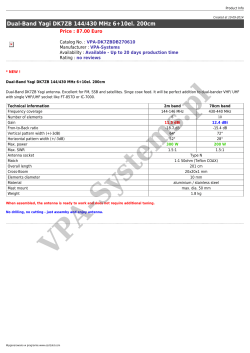
Update and Enhancements for
Update and Enhancements for 1296 MHz Transverter – Right Side Up Simple and Cheap Paul Wade W1GHZ ©2014 w1ghz@arrl.net The 1296 transverter1 has proven quite popular, with PC boards sent all over the world. My intent was to make it simple and cheap, to enable many hams to get on 1296 and get their feet wet in microwaves. The tradeoff is performance – adequate for a rover or beginner, but with lots of room for improvement. Since the original paper, I have described a number of enhancements – small amplifiers for more power2, simple preamps for better noise figure3, and simple filters4 to reduce unwanted responses. All of these can be built in an Altoids tin, or the amplifiers may be incorporated in the transverter box. The transverter LO board used an inexpensive 64 MHz computer oscillator as the local oscillator source which is them multiplied to 1152 MHz. These oscillators have proven to be stable and fairly close to frequency, but frequency accuracy can be important in weak-signal work. Replacing the computer oscillator with a 96 MHz MHz VCXO5 locked to GPS or other reference significantly improves frequency accuracy without requiring major modification to the 1152 MHz LO board, just the addition of a small VCXO board and retuning the combline filter to 288 MHz. The 96 MHz signal from the VCXO board is applied to the 1152 MHz LO board as shown in Figure 1. The crystal oscillator, Y1, is omitted, as well as R1, C1, and L1, and the voltage regulator, U1. If the LO board already has these parts, it is only necessary to remove R1 and C1 and remove power from the oscillator. The combline filter is retuned by changing the tuning capacitors – see the VCXO article5 for details. Figure 1 – 1152 MHz LO board with external oscillator Transverter Updates The 1296 MHz transverter can also benefit from some small improvements. First, the receiver front-end MMIC has become obsolete. As part of a group effort to build transverters, AE5K found that the RFMD SGA-3586Z is a good replacement. He also has some construction hints on his web page, www.4smicrowave.ae5k.us . One part of the transverter that never seemed to work well was the splitter that separates the transmit and receive paths. To keep it simple, I used a resistive divider, but it seems to have more loss than is desirable, even with our design philosophy, gain is cheap. I finally decided to try a real power splitter – the Minicircuits TCP-2-25X. At $1.99, it is about 50 times more expensive than the resistive divider, but a real improvement is worth the extra cost. For the latest batch of PC boards, I modified the splitter footprint to accommodate the Minicircuits part or the simple resistor version. I also modified the MMIC footprints for the transmit amplifier to accommodate MMIC SOT-89 packages with a ground tab, like the GVA-84+, or the traditional 4-lead MMICs. The receive amplifier footprint was modified as well, in case better parts become available. Figure 1 is a photo of the new board version, with the power splitter and a GVA-84+ output amplifier. Figure 2 – Latest PC board revision of 1296 MHz Transverter Performance of the new version is improved. Transmit power is linear up to about 10 mW with 144 MHz input of -5 dBm, and can be driven up at least 5 more dB; the old version saturated around 8 mW out. Receive noise figure is about 5 dB, vs. about 8 dB for the old version. This NF was low enough that I wanted to be sure it was only at 1296 MHz, so I put a good interdigital filter in front of the transverter – the NF rose to about 5.5 dB, so the number is real. Then I added a PGA-103 preamp3 before the filter, which dropped the NF to about 1.3 dB. This performance is getting serious! An updated schematic diagram with the enhancements is shown in Figure 2. Figure 3 – Schematic Diagram of latest revision of 1296 MHz Transverter A further note about the power splitter – I didn’t get the footprint quite right on the PC layout. Figure 3 is a picture I took with a Radio Shack “Mobile Microscope”, which clips on to a smartphone camera. It was on sale for $14.95, and is really useful for reading tiny part numbers and inspecting surface-mount soldering. The specified TCP-2-25X outputs are pins 3 and 4, while the common port is pins 2,5, and 6; pin 1 is ground. I couldn’t find any connection to pin 1or pin 2 on the actual part, so I didn’t worry about the grounding. In Figure 1, I cut away the copper so pin 1 floats, but in Figure 3 I just ignored it. If you are retentive about following data sheets, find a way to ground pin1. I also made R1 = 100 ohms on the unit I tested, because I looked at the wrong data sheet. It works so well that I didn’t change it, but Figure 3 includes the correct value . Figure 4 – Closeup of Power Splitter assembly One last suggestion for keeping things cheap – a significant part of the cost is the SMA connectors. I have found Chinese SMA connectors on ebay for about $1 each that seem to work up to at least 1296 MHz. If they aren’t quite as good, remember that gain is cheap. Stick to female SMA connectors, the snap rings on the male connectors often fail when tightening. References (all of these are available at www.w1ghz.org) 1. Paul Wade, W1GHZ, “1296 MHz Transverter – Right Side Up, Simple and Cheap,” Proceedings of Microwave Update 2009, ARRL, 2009, pp. 180-184. 2. Paul Wade, W1GHZ, “A Modest Power Amplifier for Cheap and Simple Microwave Transverters,” Proceedings of the 46th Conference of the Central States VHF Society, ARRL, 2012, pp. 121-122. 3. Paul Wade, W1GHZ, “Simple Cheap MMIC Preamps,” Proceedings of the 48th Conference of the Central States VHF Society, ARRL, 2014, pp. 204-214. 4. Paul Wade, W1GHZ, “Altoids Tin Filters,” Proceedings of the 48th Conference of the Central States VHF Society, ARRL, 2014, pp. 192-203. 5. Paul Wade, W1GHZ, “Locked VCXOs for Stable Microwave Local Oscillators with Low Phase Noise,” Proceedings of Microwave Update 2013, ARRL, 2013, pp. 121-143.
© Copyright 2025












